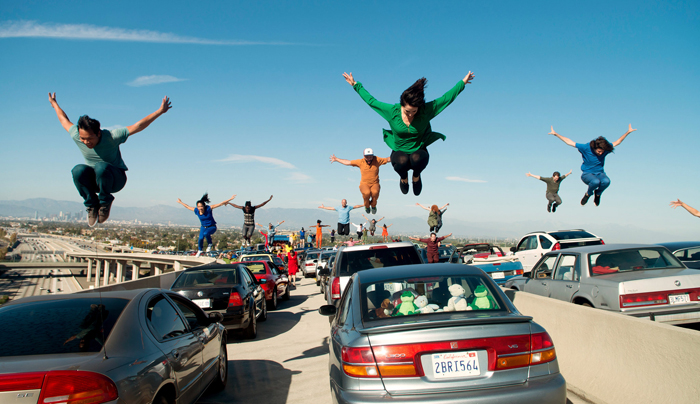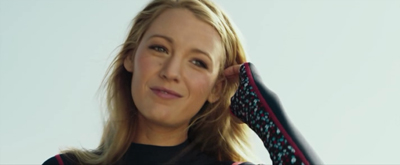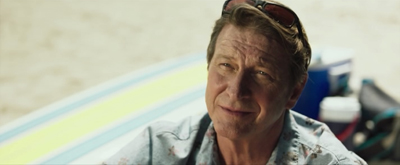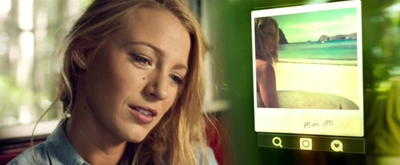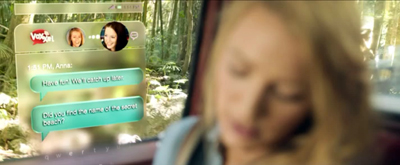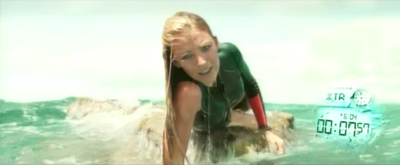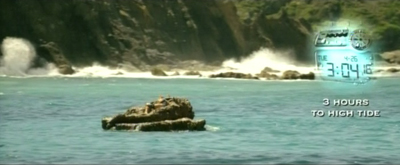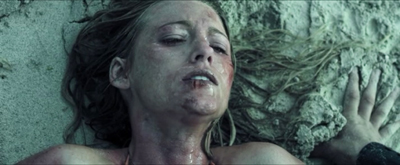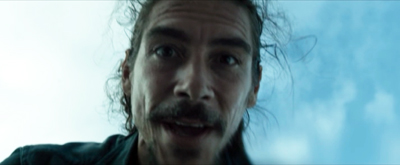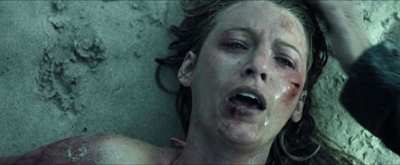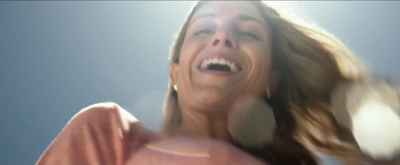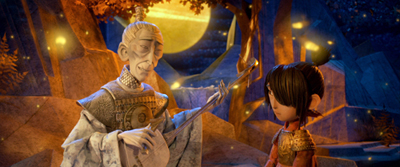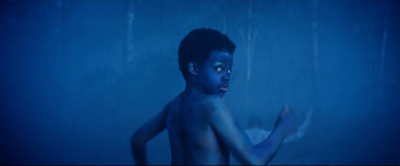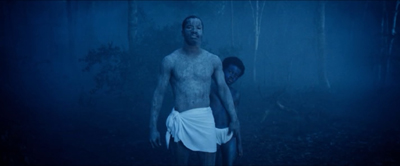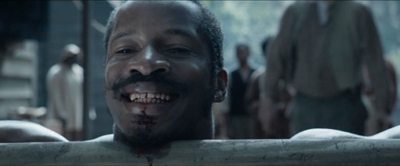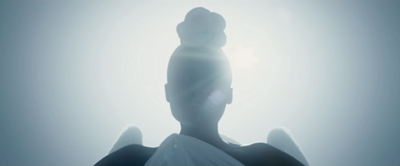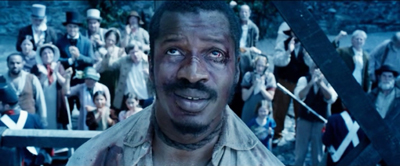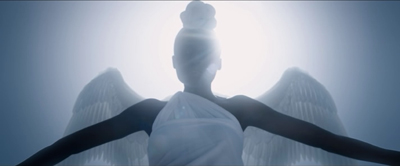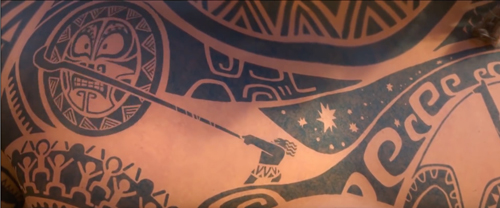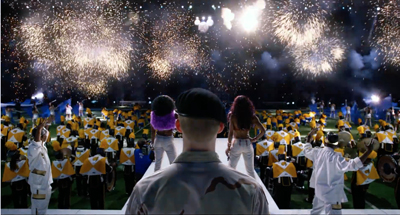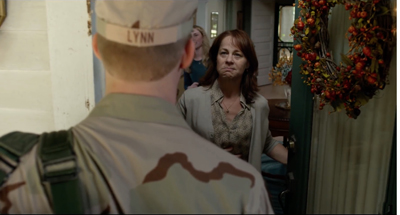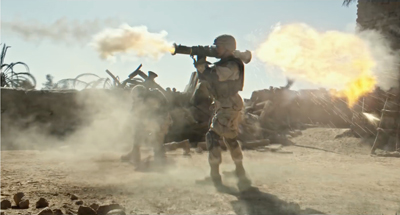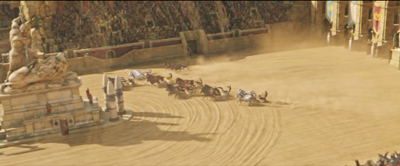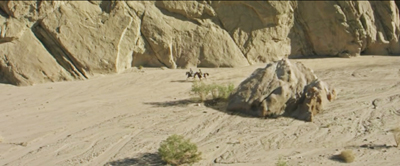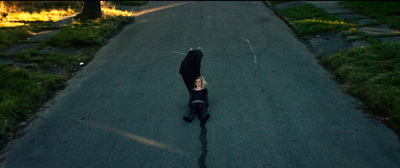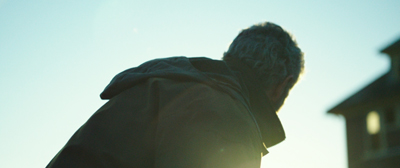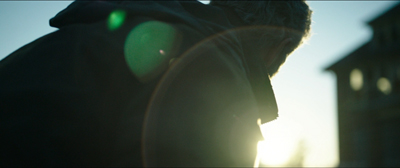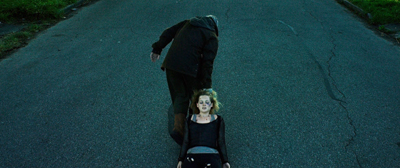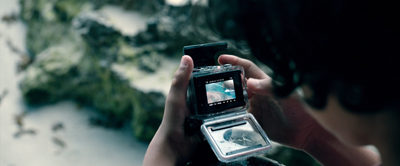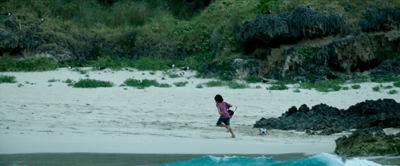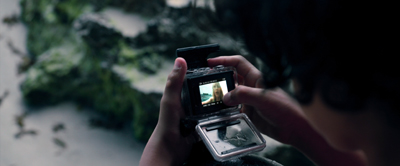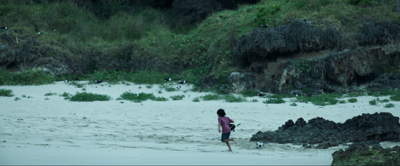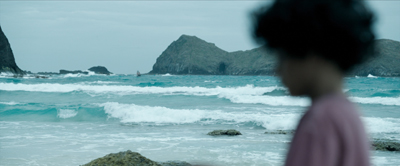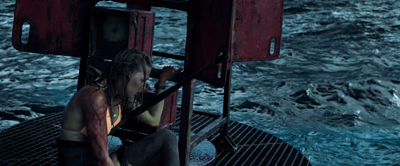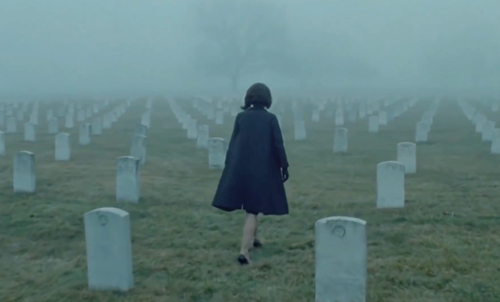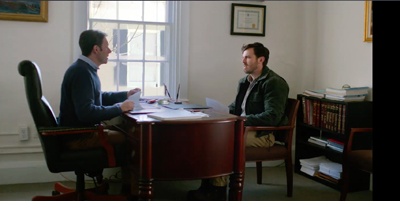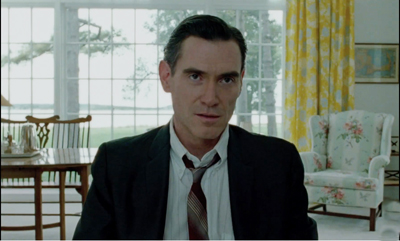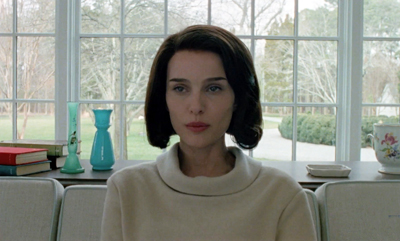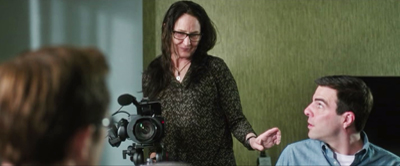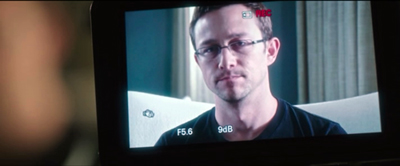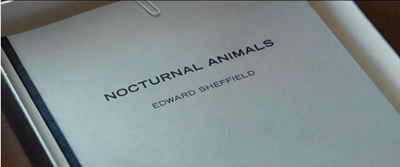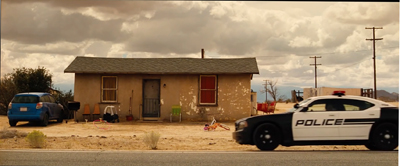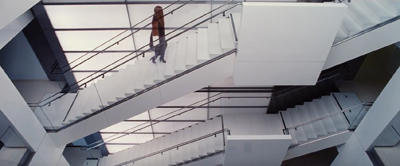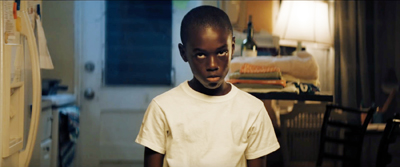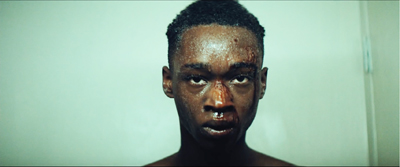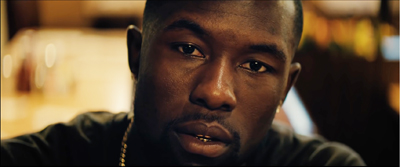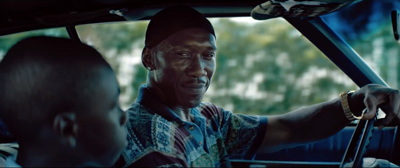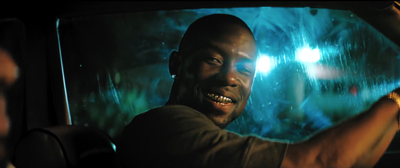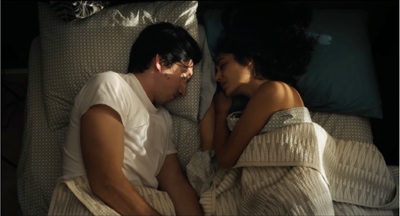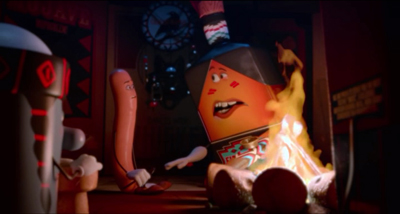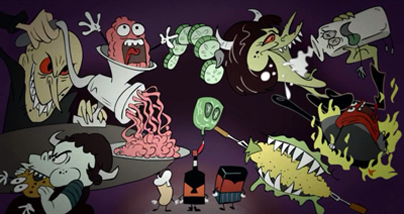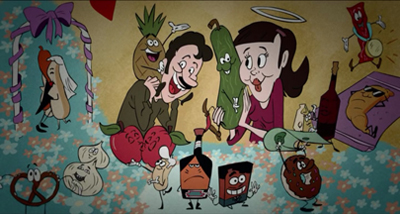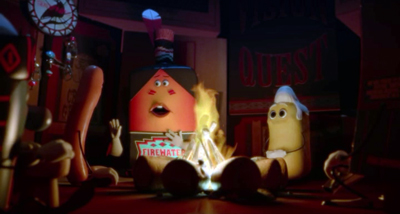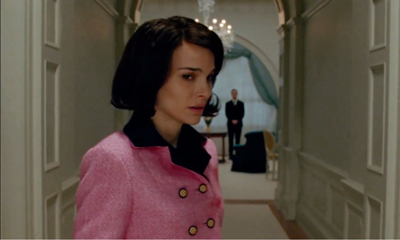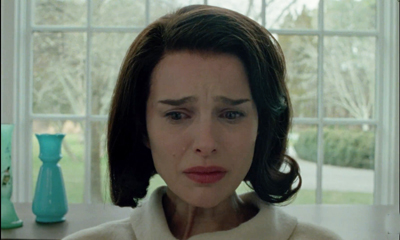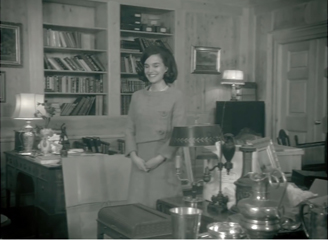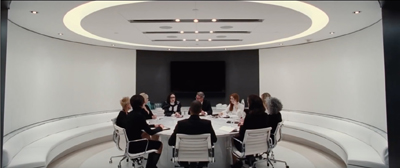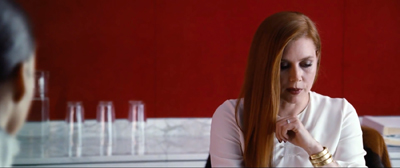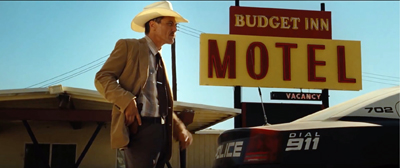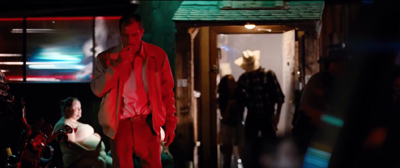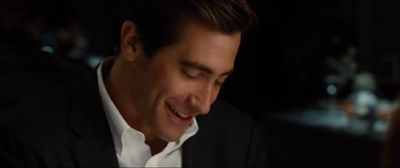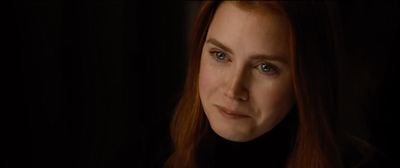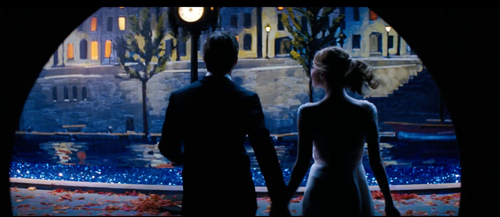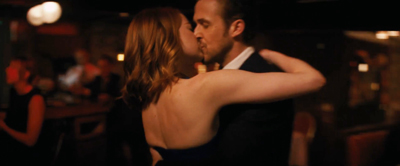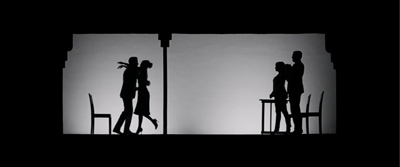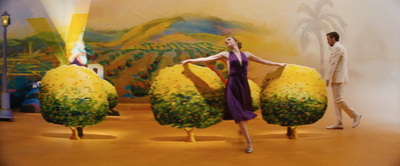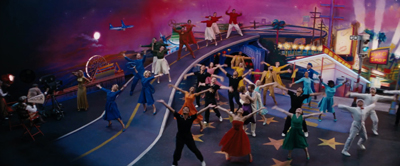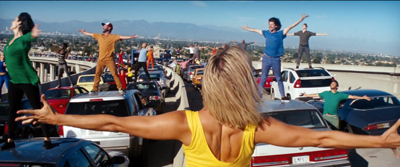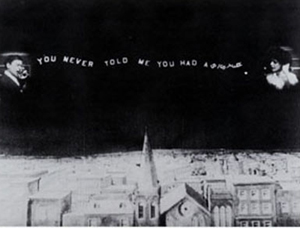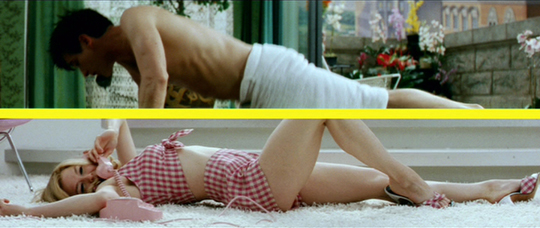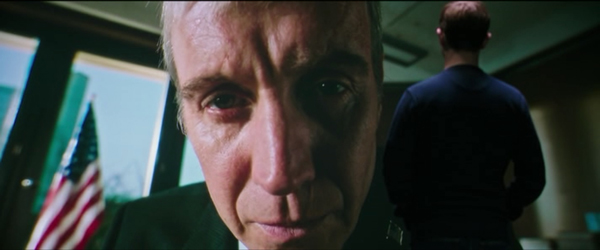Fantasy, flashbacks, and what-ifs: 2016 pays off the past
Monday | January 2, 2017 open printable version
open printable version
La La Land.
DB here:
After I see a new movie, I like thinking about its ties to film history. This isn’t a matter of sneering, “They did it better in the old days,” though often that’s true. Rather, I like exploring how our films both rely on and swerve from the traditions they invoke.
I’m not talking only about movies that self-consciously point at Hollywood’s past, as La La Land does. Every new release participates in film history—and sometimes changes it. Most critics don’t have the space or inclination to point this up, but those of us who study film as an art can. Looking closely at form and style makes the past present to us in a vivid way.
Students are taught that in the 1910s Griffith took crosscutting to a new level, and true enough. But it’s not often mentioned that crosscutting has remained a permanent expressive option for filmmakers today. Very often they use it as Griffith did: to build tension, especially in a chase or a race against time; or to highlight narrative parallels, as he did in Intolerance. What excites young audiences in the work of Christopher Nolan, for example, are in large measure smart elaborations on principles that go back a hundred years.
This isn’t to complain that Nolan isn’t original—originality in the strong sense is very rare—but rather to point up an overarching dynamic of continuity and change across the history of the art. We understand what Nolan’s doing better when we see how he recasts inherited techniques, as when Inception takes parallel crosscutting to a kind of limit in its embedded dreams.
My upcoming book, Reinventing Hollywood: How 1940s Filmmakers Changed Movie Storytelling, is an effort to refine an argument I made in The Way Hollywood Tells It: that major narrative techniques of contemporary cinema got consolidated in the 1940s. The techniques I have in mind include general principles like non-chronological plotting and subjective probing of character’s experience, as well as particular devices like flashbacks, voice-over, and fantasy scenes.
I say “consolidated” because many of those strategies can be found sporadically in the silent era and the 1930s. Forties writers and directors adapted them to the sound cinema, made them popular, and explored them in ways that go beyond most earlier instances. These filmmakers added a body of resources to the classical tradition: after the 1940s, later filmmakers could develop the techniques in fresh ways. There were new colors on their palettes.
I talk about several films, and among those I significantly spoil The Shallows, Manchester by the Sea, The Birth of a Nation, Nocturnal Animals, Moonlight, and La La Land. But you should be able to skip the films you fear I’ve overshared on.
Schemas and their sneaky ways
Reinventing Hollywood argues that we can understand the process as one of schema and revision. I borrow from E. H. Gombrich the idea that a schema is a pattern handed down by earlier artists that becomes a point of departure for those who follow.
For example, shot/reverse-shot cutting is a stylistic schema, going back to the 1910s. Every professional filmmaker knows how to execute it, though some will find fresh ways to use it. The Shallows, a summertime thriller from the talented director Jaume Collet-Serra, uses it in orthodox ways throughout.
Most filmmakers apply the shot/reverse-shot schema to phone conversations as well. But here Collet-Serra innovates (mildly) by using cellphone technology to give us a phone conversation with a redoubled shot/reverse-shot pattern. The editing schema is given within a single frame as Nancy talks with her father.
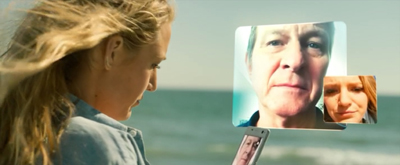
This isn’t, I think, a mere gimmick. For one thing, we’re primed for it by the scene of Nancy’s arrival, when she browses through photos of her dead mother. Those are delivered to us as paste-ups in the same frame, rather than as optical POV shots of Nancy’s phone. Soon after, still during her ride to the beach, we see an instant message from her friend.
So the pseudo-shot/reverse-shot has been prepared for by these other displays of her screen. We’re ready for this to be an intrinsic norm of this film. Later we’ll get the ticking-clock deadlines through inserts of of her watch.
More generally, the film as a whole tightly restricts us to Nancy’s experience. Nearly everything we see and hear is filtered through her consciousness. (The film’s momentary detours from her range of knowledge work to maximize suspense, in the manner of the bomb under the table.) During the phone conversation, cutting back to her father at home in Galveston would have made him a more important character. As it is, the narration keeps the emphasis on her situation and the beautiful but menacing landscape, the “perfect beach” that she needs to conquer as her mother did.
Shot/reverse-shot is a schema for handling stylistic options. I suggest that there are narrative schemas too, tried-and-true storytelling patterns that filmmakers can repeat, reject, or revise. Novelty builds on familiarity. As Damien Chazelle describes La La Land: “I’m trying to hark back to certain old traditions but hopefully show you something you haven’t seen before.”
For the viewer, schemas supply a certain predictability. We’re used to the back-and-forth of shot/reverse-shot cutting. Likewise, we expect a flashback to supply background information that clarifies the situation in the present. In the American studio tradition, a filmmaker who revises a schema needs to give us enough of the pattern to make us realize the alterations. The Shallows‘ revision of shot/reverse-shot is clear to us because, given our knowledge of FaceTime/Skype technology, we can grasp the images as diagrammatic presentations of a familiar editing pattern. Similarly, we can sense a flashback even when it’s quick or cryptic, and we anticipate that things will clarify later. The dynamic of familiarity and novelty will work only if the the new twist plays off something recognizable.
Back in September, I noted that almost every film I was seeing seemed indebted to 1940s storytelling, but I talked only about Sully. Today I go wider and look at several 2016 films, both pop and prestigious, that rely on methods of roundabout storytelling that coalesced back then. We’re so used to these methods that we tend to forget their debts. By analyzing how our writers and directors draw on this tradition, we better understand their roots in film history–and their genuine contributions to changing it.
In her, and his, shoes
One of the most taken-for-granted narrative strategies is that of subjectivity. Here filmmakers use images and sounds to reveal a character’s mind and senses. The main schemas have become very familiar.
Today we scarcely notice optical POV shots or fantasy imagery. They were common in silent film, became less common in Hollywood in the 1930s, and grew very common in the 1940s. The sustained optical POV of Lady in the Lake (1947) is one instance, and so are the protracted dream and delirium sequences in psychological films like Spellbound (1945) and The Lost Weekend (1945).
Go back to The Shallows and you’ll find plenty of POV shots. When Nancy regains consciousness after the climax, we get a mixture of optical viewpoint and imaginary shots, when she first sees Carlos and then “sees” her mother’s approval of her courage.
Dreams are another common device for rendering subjectivity. They became commonplace in the psychoanalytical films of the 1940s, and have been used ever since to probe the more or less unconscious impulses of our characters. We’re let in on characters’ dreams in A Quiet Passion, Hacksaw Ridge, and Kubo and the Two Strings.
Both visions and dreams become important motifs in The Birth of a Nation. Early in the film, the child Nat Turner, who has been called “a leader and a prophet” by an elder slave, dreams of himself in tribal paint running through a forest. Later, grown-up and developing a sense of himself as a rebel against oppression, he re-experiences the dream, only now the child encounters himself as an adult, who moves to protect him. The child becomes father to the man.
These plunges into subjectivity run along with images of Nat’s revelation: an angel he sees at moments of greatest torment, on the whipping block and on the gallows.
On the second occasion, the figure is more fully revealed as an angel, and she seems ready to embrace him. The nocturnal spirituality of the opening has been counterbalanced by something like Christianity, but it’s hardly the white folks’ version: Nat sees a dark angel.
Frames and breaking frames
Moana.
Subjectivity can also shape our sense of time, thanks to flashbacks. Very common nowadays is the brief flashback representing a sudden memory. In Allied, a shot of Max and Marianne on their rooftop bed-sit in Casablanca comes when Max is recalling their mission, after he’s learned she might be a German spy. A parallel device is the auditory flashback, as when a character recalls earlier lines of dialogue, which might not be accompanied by imagery from the past scene. Several of these films drop in sonic flashbacks, which serve as reminders to the audience as well as recollections for the characters.
A subjective push into the past can take over the whole structure of the film. This happens when big stretches of the plot are presented through flashbacks to events that characters tell or remember. A fairly pure case is Billy Lynn’s Long Halftime Walk. It intercuts three time periods: the present, as Billy and his comrades in arms visit a Thanksgiving football game; Billy’s return to his family two days before the game; and the more distant events of Billy’s tour of duty in Iraq, culminating in the death of his beloved sergeant Shroom.
Throughout the film we’re largely restricted to what Billy experienced in both present and past.
In most films, though, flashbacks don’t represent memories. Often a flashback is initiated as a character’s recollection or testimony, but it presents events that a character didn’t know about. In these cases, the film has it both ways–subjective when it wants us to feel with the character, but wider-ranging when the extra information can yield suspense or another perspective on what the character knows. This happens in Jackie, in which Jacqueline Kennedy tells a journalist about the JFK assassination and its aftermath. We mostly adhere to what she could have seen and heard, but some incidents occur outside her ken. The interview situation motivates the return to the past, and that’s usually what we find in these partly subjective flashbacks.
The flashback technique was fairly common in Hollywood’s silent era but rarer in the 1930s. It emerged as a major creative option in the Forties; there are more flashbacks in 1944 feature releases than in all of the Thirties. Nowadays most films, even Moana, resort to it. (Maui’s boasting song “You’re Welcome” reviews his gifts to humanity.) Virtually every film I mention today employs at least one flashback–a testimony to the enduring power of this storytelling norm.
Since even the most personal flashbacks tend to stray from what characters could have witnessed, it’s not surprising that today we commonly have completely “objective” flashbacks. The plot simply jumps to and fro through time without the alibi of character memory. Hollywood has occasional early instances (Beau Geste, 1927; A Man to Remember, 1938; Confidence Girl, 1952; The Killers, 1955), but the “external” flashback is rare before the 1960s. Over the decades, filmmakers and audiences became comfortable with the flashback that simply admits itself as such. The time shift may be signaled by a title (“Two Days Earlier” in Billy Lynn), but some films find other ways to announce the flashback.
A simple example is Ben-Hur. Steered by a voice-over narrator (who will turn out to be a character in the film), the opening shows the start of a chariot race in a Roman Circus. Two young bravos swap lines that arouse curiosity: “You should have stayed away.” “You should’ve killed me.” “I will.” Then the race starts, the camera pans left to follow it, and the shot dissolves (a graphic match) to an image of two horsemen racing around a rock.
They are youthful versions of the competitors we’ve just met, and we’ll learn that Messala is Judah Ben-Hur’s adopted brother. The rest of the plot follows the friends’ careers that lead them to the fateful chariot competition. And that opening stretch is replayed when the flashback catches up with the frame situation. We’re reintroduced to the Circus, and identical shots show them exchanging the same lines we heard at the start.
This sort of overlapping return to the frame is common when the flashback consumes a large chunk of the film. One traditional schema, used in Ben-Hur, presents the frame story as a situation in crisis. This serves to grab our attention, to raise questions, and to hold the outcome of present-time events in suspension while the backstory clicks in.
The crisis structure is seen in Hacksaw Ridge, when after glimpses of a ferocious battle we see the protagonist rushed along on a stretcher. Thanks to a title, “Seven Years Earlier,” we shift to the past in another “objective” flashback. Eventually we’ll loop back to the wounding and rescue of Doss at Hacksaw Ridge.
The earlier versions of Ben-Hur didn’t resort to flashback construction. Similarly, Sergeant York (1941), which has similarities to Hacksaw Ridge, relies on straightforward chronology. The crisis schema became popular in the 1940s (e.g., The Big Clock, 1947), but it’s even more common now than it was then.
So is a willingness to put flashbacks inside flashbacks. Hacksaw Ridge‘s main flashback breaks its own chronology to show scenes of domestic violence in Doss’s youth. The main flashback of Ben-Hur plays host to embedded flashbacks too. The large-scale Chinese-box construction of 1940s films like The Locket (1946) and Passage to Marseille (1944) is still uncommon, but brief flashbacks wedged inside a long-term one pose no problems for current audiences.
Ben-Hur and Hacksaw Ridge set up the Now situation straightforwardly and at some length. At the opposite extreme is the present-time opening of Don’t Breathe: a slow swoop down to a barren street along which a man drags a young woman’s body. A second shot isn’t very informative about him or her, and the two shots consume only 63 seconds.
Probably most viewers forget about this cryptic but intriguing crisis situation until it’s repeated at the climax–the shots in reverse order, the woman more clearly visible, and the two shots clipped to a mere nine seconds. This is compact storytelling.
The Shallows sets up its Now through attachment to a minor character. A little boy finds a video camera on a helmet floating in the surf. He plays the footage and, seeing a shark attack recorded there, runs to get help.
Later the boy’s discovery is shown again, and now we’re in a position to appreciate its importance. But like the opening sequence of Mildred Pierce, this prologue has omitted key information: the boy’s replay of Nancy’s recorded plea for help. At the climax that footage, which we’ve seen her make, is is now re-run for us as the boy watches it. Again the boy is shown running for help. This overlap brings us up to the original Now.
At the start there was an enigmatic rack-focus to the buoy in the distance. In the replay, while the boy studies the video, we see Nancy bobbing there, waiting for the shark to attack.
This scene, incidentally, shows how a flashback structure can take the sting out of a convenient coincidence. If something unlikely–the boy discovering the camera in time to help the heroine–is shown before the main action, then it doesn’t seem as out-of-nowhere as it would if presented in straight chronology. After seeing the somewhat cryptic opening, we might even be looking forward to the revelation, as presumably some viewers are when a scene in the flashback introduces the surfer with the camera helmet.
Interestingly, neither Don’t Breathe nor The Shallows resorts to a title announcing the transition from Now to the past. Can it be that our genre pictures can live with a little less redundancy than our Oscar bait?
Strands, mosaics
Jackie.
Filmmakers never tire of tweaking flashback conventions. A more subdued variant of the crisis setup is used in Manchester by the Sea. Joe Chandler dies and his brother Lee, working as a maintenance man in Boston, is summoned back home to Manchester. These scenes alternate with episodes from the past, out of order, showing the brothers’ relationship and Joe’s eventual death. The crisis comes about fifty minutes into the plot, when in a lawyer’s office Lee learns that Joe wanted him to take custody of his son Patrick and move back to Manchester.
Lee’s resistance to this plan is explained in another string of flashbacks that show the disintegration of Lee’s marriage, the death of his children, and his attempted suicide. He has left the town behind and lives in self-inflicted pain and isolation.
At this point, the film reverts to chronology in the Now. The drama pivots around Lee forging a relationship with Patrick and coming to terms with his past. Only two brief flashbacks break up the story line, and those relate to Joe’s disappointment at Lee’s retreat from the world into a menial job. If the first half had been presented chronologically, we would have lost the sharp contrast between Lee’s scowling reluctance to reach out to Patrick and the more vigorous, emotionally open man he once was. Hollywood films may not excel at portraying gradual character change, but flashbacks allow a sharp sense of Before and After that can suggest how humans remake themselves in response to events.
The mosaic quality of the flashbacks dotting Manchester by the Sea can be seen to a lesser extent in Jackie. Here there are four principal strands of time to be interwoven, with glimpses of others. One strand involves the Kennedy assassination and its aftermath–the public ceremony of the display of his body and his burial in Arlington. Another involves Jackie’s consultation with a priest some time after JFK’s death, discussing her plans to bury their first two children, who died as babies, alongside him. A third strand, temporally pre-assassination, presents her famous 1962 tour of the White House. Finally there’s her post-assassination interview with a reporter who asks her questions about her role as First Lady and her handling of the horrific Dallas tragedy. We also get glimpses of the 1960 inauguration ball and Pablo Casals’ 1961 concert at the White House.
The film opens with the reporter calling on Jackie and the two settling down for their talk. He’s a bit provocative and probing, she’s guarded and self-censoring. The somewhat odd angle of the shot/reverse-shot framings, with her eyeline only a little off-center and sometimes straight at the camera, conveys an eerie ceremonial stiffness.
The reporter’s interview seems to be the frame for the flashbacks. Not only does their meeting occupy the normal position of a framing situation, but we’re aware that another schema triggering flashbacks is a testimony situation. In court, in a police station, at home quizzed by a reporter: These often set up a flashback narrative. The probing-reporter schema was crystallized in the 1940s with, of course, Citizen Kane (1941) but also with earlier films like The Escape (1939), Edison the Man (1940), and The Great Man’s Lady (1941).
Snowden is a good contemporary example of the reporter-interview frame. Long blocks of flashbacks are enclosed within a ticking-clock situation in the present. Snowden retells his life, in chronological order, for Laura Poitras and Glenn Greenwald.
The film’s narration is largely tied to his range of knowledge during those periods, especially when suspense is at stake. We get plunges into subjectivity when he’s struck by epilepsy, and much optical POV cutting, notably when he downloads the NSA files as officials mill around outside his cubicle. As often happens in classical filmmaking, the narration widens its perspective to provide montages of news reports and reactions to Snowden’s revelations by his associates around the world.
Snowden tidily frames its past episodes by the present-time action before and after the big interview. The final scenes, and the credits, show the consequences of his whistle-blowing in the days and years afterward. But Jackie revises the testimony schema in an unusual way.
As the film goes on, it’s revealed that the reporter’s interview with Jackie isn’t the ultimate Now. The last events in the story chronology are Jackie’s consultation with the priest and the burial of her children. But from about 45 minutes onward, the priest’s attempts to console her are intercut with the interview. They are, in other words, flash-forwards.
They’re initially concealed as such because they follow Bobby Kennedy’s suggestion, in the assassination’s aftermath, that Jackie talk to a priest. That cue inclines us to assume that the priest’s advice is given during her final days in the White House. Only when the reporter phones his editor and says Jackie intends to bury the children beside Jack, and when Jackie tells the priest that the reporter’s story went around the world, are we aware of the burial scene’s place at the very end of story chronology.
This is a cogent example of schema revision: a frame that doesn’t enclose everything that, by convention, it should. One effect is to make the burial of the children an unexpected climax–a revelation of how much death this woman has seen, and a counterpoint to the glittering image of “Camelot” on which the film closes.
So where you put your flashbacks turns out to be crucial. Had the flashbacks to Lee’s tragic mistakes in Manchester come earlier, we’d probably be less sympathetic to him than we are; by the time of their arrival, we’ve seen his long-term suffering and are prepared to have a complex judgment of him. The timing of flashbacks also shows to good effect in Nocturnal Animals.
Most of Nocturnal Animals is dominated by another device for braking chronology: the embedded story. Here a plot involving new characters is wedged within the main story. Novels have done this for some time, as when a character discovers a manuscript that opens a story world containing a completely new cast. In the comic book Watchmen, the story Marooned is read by a minor character in the main plot.
In films of any period, such discrete embedded tales are rare. In the 1940s, the chief variant involves dream plots: the protagonist falls asleep and the dream consumes the bulk of the film, as a long flashback might. The main character might retain her identity, as Dorothy does in The Wizard of Oz (1939), or the dream character might be a new persona, as in Du Barry Was a Lady (1943), where Red Skelton becomes King Louis XV. Either way, an alien story world is opened up.
Nocturnal Animals contains an elaborate embedded story. Art-gallery owner Susan Morrow is in the dumps; her chi-chi friends are cold and her husband is having an affair. She receives the manuscript of a novel from her first husband Edward. Over some days Susan reads this harrowing pulp exercise set in west Texas, and it’s dramatized for us in chunks. interspersed with her daily routines.
At first we might think that the novelistic sections are “objective” presentations of the scenes, a parallel fictional world. But about 45 minutes into the film, we get a flashback to Susan meeting Edward at the start of their romance. (Actually, it’s a re-meeting; they had crushes on each other years before.) Thereafter flashbacks to their courtship and their marriage are interspersed with more stretches of the novel. Tony, the hapless, somewhat spineless protagonist of the novel, is played by Jake Gyllenhaal, who also plays Edward.
The flashbacks invite us to find a dose of subjectivity here. Is Susan reading the novel as a portrayal, deliberate or unwitting, of Edward’s feelings of inadequacy in their marriage? She cheated on Edward with the man who became her second husband, so she may also be projecting her own guilt onto the terrifying fate of Tony’s wife–interestingly, not played by Amy Adams, the actress portraying Susan.
In Nocturnal Animals, the frame is neater than in Jackie; at the film’s end we return to Susan’s present life. But an ambiguous ending asks us to consider how fully we have entered into her imagination.
There’s a more drastic revision of the flashback schema, or rather the audience’s presuppositions about it, in Arrival, which I’ve talked about here. But interesting flashbacks with a 40s flavor are also at work in James Schamus’s Indignation, analyzed here.
Strands or blocks?
I think these examples show that it can be useful to think about film narrative from the standpoint of craft. Since the filmmakers made choices, what rationale justifies them choosing what we have rather than what we might have had?
For example, it would have been perfectly possible to arrange the time-layers of Jackie or Manchester by the Sea as blocks, separate chapters (perhaps given titles or dates) rather than as interwoven strands. Similarly, Nocturnal Animals could have shown us Susan’s marriage to Edward as one block, then her life with her second husband, and then the embedded novel as one long stretch. Thinking about how these alternatives would alter our experience can give us insight into the benefits and costs of the choices the filmmakers went with.
Block construction became a somewhat popular storytelling option in the 1940s. Long flashbacks balanced against one another can create blocks, as in Citizen Kane and A Letter to Three Wives (1948). Similar were “chaptered” films like Holiday Inn (1942) and Meet Me in St. Louis (1944) and the episode-based films Fantasia (1942), Tales of Manhattan (1942), Flesh and Fantasy (1943), and others. Welles, always alert to trends, planned such a structure for It’s All True.
2016 has given us two pure examples of block construction, both of considerable interest. The most visible one is Moonlight, which tells its character-centered story in three phases of the life of Chiron: his boyhood, his teenaged years, and his early adulthood.
The sections are announced by titles: Little, Chiron, and Black. The first two stretch over several weeks and show Chiron bullied by other kids and neglected by his crack-addicted mother. He also encounters helpers, at first the easygoing drug dealer Juan and his girlfriend, and later his schoolmate Kevin, who in the second episode is forced by the other boys to beat Chiron. The final episode unfolds in a single night. Chiron, now called Black and grown to be a powerful man, has become a drug dealer and is filmed somewhat parallel to Juan.
Black visits a diner where Kevin works. Tentatively their affection and sexual yearning for one another are rekindled.
As with any creative choice, there are trade-offs. Moonlight‘s sharply-edged episodes refuse a smooth arc of action; they sample his life and deny us a clear “coming of age” process. There are gaps between the stories, and the one between the second and the third episodes is crucial. We’re left to imagine what happened to Chiron that turned him into the muscled, tough Black. Perhaps the fight that got him sent out of school–the moment when he fought back at the main bully–marks his turning point. Surely too his prison experiences shaped his transformation, but we neither see those nor hear him tell about them. Director-screenwriter Barry Jenkins has left us to note the vivid change in character without supplying what Henry James called the “weak specification” of all the events that shaped him. Block construction has left empty spaces for our imagination to fill.
Another fairly pure case of block construction is Paterson. (I discuss it briefly here.) The plot consists of a week’s worth of events, broken into days starting on Monday. We follow Paterson the bus driver on his daily rounds of going to work, doing his driving, coming home to his wife, walking their dog, and sometimes paying a night visit to a local tavern. Some incidents are variants of others, such as the morning conversations with Donny, Paterson’s supervisor, or the glimpses of different sets of twins around town.
The daily blocks are marked, at least initially, by a title stating the day of the week, but this pattern is varied: No titles for the weekend. Another marker is the opening shot of each segment showing Paterson and his wife in bed from straight above them.
This image varies too, with different compositions and shot scales each morning, and in one case, Paterson alone. Cinematographer Frederick Elmes explains that each day changes:
So there’s a routine. He’s going to leave and return to the house at the same time every day, so it’s going to look the same. I said to Jim [Jarmusch, the director], “It might be nice to have some gentle differences between them, to define one day from the next.” That became our task, finding ways of keeping things visually interesting without going too far.
Today block construction often calls forth the sort of stylistic tagging pointed out by Elmes. The same differentiation of visual textures is found in flashbacks. A funny example occurs in Sausage Party, when Firewater explains how the Non-Perishables created the myth of humans as kindly gods. The framing situation in the present is given in chiaroscuro imagery with thick volumes and plausible (for a cartoon) depth. The flashback to humans’ slaughter of the groceries is rendered in a screeching, retro/headcomix style and an abstract space.
This style is maintained for the fantasy version that Firewater and his cronies concocted to keep the groceries from panicking. Then we return to the narrating frame.
Not gentle differences here: glaring ones, suitable to comic exaggeration.
Something in-between operates in several of the films I’m considering. In Café Society, two cinematographic styles differentiate between the major locales, Hollywood and New York. Jackie‘s post-asssassination flashbacks are filmed in a free-camera style distinctly different from the locked-down, planimetric shots of the interview and the more studio-bound images of the TV filming of the White House Tour.
Likewise, Nocturnal Animals assigns three different “looks” to its three levels. DP Seamus McGarvey explains that Susan’s present had to be “colorless, [with a] low-contrast anemic aspect to it.” The story within the story is “colorful, more primaries.” The flashbacks to Susan’s and Edward’s marriage have a softer, glowing texture.
Visually tagging blocks, fantasies, and flashbacks wasn’t uncommon in the silent era, when filmmakers marked them with vignettes and soft focus. These optical devices, along with distorting lenses, were occasionally used in the sound era too, along with occasional shifts between color and black-and-white (The Wizard of Oz; Portrait of Jennie, 1949). On the whole, differentiating strands or blocks became a firm craft convention somewhat later, from the 1980s on. I talk about how that happened in The Way Hollywood Tells It.
Ooh-La-La Land
Believe it or not, I haven’t exhausted the debts of 2016 movies to Hollywood in the Forties. There is, for instance, the device of voice-over, so common in that decade, which reappears in various guises, most notably that of the gossipy narrator of Café Society. There’s also the strategy of confining the bulk of the film’s action to a single location, which became notable in Angels over Broadway (1940), Lifeboat (1944), Rope (1948), and The Time of Your Life (1948). That method, common to low-budget thrillers, was ingeniously exercised in 10 Cloverfield Lane, The Shallows, and Don’t Breathe. In another entry I’ve discussed how Sully uses the device of replay that became common in the 1940s.
La La Land sums up several of the tendencies I’ve mentioned. It displays block construction, with sections labeled Winter, Spring, Summer, Fall, and Winter… Five Years Later. The film’s first section uses the flashback technique too. After we follow Mia out of the traffic jam and to the party and the piano bar, the narration jumps back to the traffic jam and tracks Sebastian through his day up to the moment he pounds out jazz at the piano. This brings them together. As she’s about to compliment him on his playing, he brushes past her and leaves. At about 25 minutes in, this is the turning point ending the film’s first part.
The rest of the film traces their other coincidental meetings until they fall in love, try to maintain their relationship, and ultimately break up. They re-meet at Sebastian’s club, with Mia now married to a courteous side of beef. As the two look at each other and Sebastian takes over the piano to play their love theme, the film skips back to the first piano-bar encounter. Instead of passing Mia, though, Sebastian grabs her and they kiss.
Now the narration posits an alternative story line in which they marry, become parents, and still have success. This what-if scenario is rendered in stylized settings, accompanied by moments of dance.
Like the visual tagging of blocks and flashbacks, this sequence needs to abstract its settings, theatricalizing them so they’re set off from the real-world locales in which our characters have also been singing and dancing.
La La Land revisits a schema that was explored a little in 1930s and 1940s Hollywood: the alternative-universe story line created by forking paths. I’ve talked about the clearest early example, the 1934 film adaptation of the play Dangerous Corner. It’s a Wonderful Life (1947) did it negatively: Imagine a universe without you (or George Bailey). A little-known instance from that period is Repeat Performance (1947), which offers its actress-heroine a narrative reset like that to come in Groundhog Day (1993), Run Lola Run (1998), Source Code (2011, talked about here), Edge of Tomorrow (2014), and many other media texts, including comics.
Again,the schema is creatively reworked. The past the couple might have had is played out with parallels to the real-world life that Mia found. The result is an epilogue balancing the traffic-jam prologue–these people, unlike the gridlocked drivers, have found their success in Show Biz–but at the cost of love. By showing us what might have been, the final sequence provides something both wistful and satisfying.
I regret missing certain films this year, particularly Kelly Reichardt’s Certain Women, which seems to constitute an intriguing instance of block construction merged with a minimal network narrative. I look forward to catching up with it. And I’ve confined myself to Hollywood and off-Hollywood films, but I could easily have stretched the boundaries to include Elle (flashbacks), I Am Not Madame Bovary (block construction), Sieranevada (confined-space shooting, discussed by Kristin), Julieta (flashbacks, voice-over, etc.. etc., discussed in another entry), and many other imported films. These narrative strategies now belong to contemporary movie storytelling as a whole.
I don’t want to leave the impression that as I’m watching new release a little homunculus historian in my skull is busily plotting schema and revision, norm and variation. I get as soaked up in a movie as anybody, I think. But at moments during the screening, I do try to notice the film’s narrative strategies. Later, when I’m thinking about the movie and going over my notes (yes, I take notes), affinities strike me. By studying film history, most recently Hollywood in the 40s, I try to see continuities and changes in storytelling strategies. These make me appreciate how our filmmakers creatively rework conventions that have rich, surprising histories.
Thinking along these lines has made my 2016 moviegoing all the more fun. And a happy 2017 to you too.
E. H. Gombrich explains the concept of the schema throughout Art and Illusion, particularly in Chapter V and on pp. 313-314.
My quotation from Damien Chazelle comes from Mark Dillon, “City of Stars,” American Cinematographer 98, 1 (January 2017), 57. The same issue’s story “Quotidian Vision,” by Iain Marks, includes the remark from Frederick Elmes (p. 22). Seamus Garvey’s comments on the visual styles of Nocturnal Animals comes from Carolyn Giardina, “Beginning First in the Darkness, Then Moving toward the Light,” Hollywood Reporter, Awards no. 1 (December 2016), 48; apparently not available online. In the same article Vittorio Storaro talks about differentiating New York and Hollywood pictorially in Café Society.
The cellphone conversation in The Shallows is an interesting turn back to a much older schema for representing phone conversations, using split screen. The first one below is is from College Chums (1907). We’ve seen similar phone-call diagrams since then in Pillow Talk (1959), Bye Bye Birdie (1963), and Down with Love (2003, also below). Everything comes back eventually.
Other discussions of stylistic schemas hereabouts are in entries on lipdubs, shot/reverse-shot cutting, and Wes Anderson’s narrative worlds.
There’s another flashforward in these films: La La Land embeds a montage of the couple’s creative work in their “City of Stars” duet at the piano. Another, smallish block, it anticipates the looped construction of the final fantasy epilogue.
Snowden: Yet another revision of the shot-reverse shot schema, adapted for what John Dean called “telephonic communication.”












